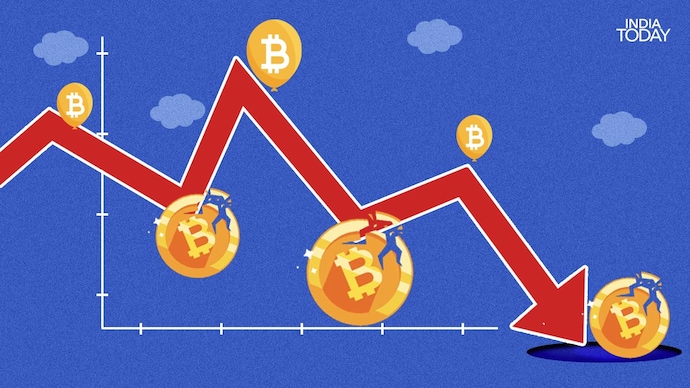The Crypto Meltdown, explained

Investors, especially those in cryptocurrencies, won’t soon forget November 2022. The worst could still happen.
In the past two weeks, the multi-billion dollar cryptocurrency exchange FTX, founded by one of the sector’s biggest and brightest stars, Sam Bankman-Fried, has imploded, much to the horror of the sector’s stakeholders.
The entire ecosystem’s foundation was shaken by FTX’s failure. All token prices fell as investors rushed to sell risky positions. Contagion then set in. Depositors frantically attempted to withdraw their funds from various cryptocurrency platforms during the panic, forcing lenders to halt withdrawals and placing the market on “death watch.”
Bankman-Fried transformed from a hero to a villain over night.
Where did we come from? Can cryptocurrency endure? Even though the story is far from over, this information is important if you’re just tuning in.
A brief recap about Cryoto scene
FTX and Bankman-trading Fried’s firm, Alameda, were linked in a Coindesk article from November 2 that cited a leaked financial document that raised concerns about their working relationship. They appeared to be two separate businesses owned by two different people on paper. Alameda, however, “rests on a foundation made up largely of a coin that a sister company invented,” according to the Coindesk article.
A few days later, the CEO of Binance, the biggest rival of FTX, declared that the company would also liquidate $580 million worth of FTT, FTX’s proprietary token. That sparked a wave of drawdowns that FTX was unable to handle with its available funds.
Spreading panic caused the value of more popular cryptocurrencies like bitcoin, ethereum, and solana as well as FTT to plummet.
A severe liquidity crisis affected FTX. It required a bailout, and for a brief moment, it appeared that only its rival Binance, whose drawdown exacerbated the crisis, could save it. Less than a day after announcing the rescue strategy, Binance withdrew, claiming that FTX’s issues were “beyond our control or ability to help.”
On November 11, Bankman-Fried submitted his resignation as the exchange’s CEO and FTX and Alameda declared bankruptcy. He apologized profusely on Twitter, “I f**ked up.”
John J. Ray III, a restructuring specialist hired by House of Cards FTX, was named CEO to lead what was left of the company through bankruptcy. In order to do that, one must carefully examine the company’s financial statements and determine the exact amounts of its assets and liabilities.

Ray says it’s the biggest mess he’s ever seen, and it’s only been a week. That’s coming from a senior executive who built his reputation managing Enron’s liquidation, the biggest bankruptcy reorganization in US history.
In a court document filed on Thursday, Ray stated, “Never in my entire career have I seen such a complete failure of corporate controls and also such a complete absence of such trustworthy financial information as occurred here.”
The filing contains proof of massive mismanagement and conceivable fraud occurring under Bankman-direction. Fried’s
No criminal charges have been brought against Bankman-Fried. A request for comment from CNN Business was not answered by his attorney.
A crypto-contagion
The cryptocurrency sector is anxiously awaiting the next domino to fall. The crypto equivalent of a bank run, requests from customers seeking their money back flooded crypto firms soon after FTX crashed. As they work to solve their liquidity issues, several firms have been forced to halt withdrawals.
Daniel Roberts, editor-in-chief of Decrypt Media, a news outlet specializing in cryptocurrencies, said: “In the crypto world, the minute you see a good company or firm announce ‘we’re temporarily been halting withdrawals’ — yikes. “You now have them on death watch,” When someone says, “We’re halting withdrawals,” they don’t immediately follow it up with, “OK, withdrawals are back on, we’re good.
BlockFi, a lender, is one of the companies that is at risk because it has “significant exposure” to FTX. Most BlockFi operations have been put on hold. The Wall Street Journal reports that the business is getting ready in case it files for bankruptcy.
Not only crypto companies are experiencing pain. Sequoia Ventures reduced its $210 million investment in FTX to zero. Similar to this, the $95 million investment made by the Ontario Teachers’ Pension Plan has been deemed worthless. Another million or so people might have lost everything they invested in FTX.
In the meantime, Binance is stepping in as a best potential lifeline for businesses affected by the collapse of FTX. Changpeng Zhao, the company’s CEO, announced on Monday that his team would create “an industry recovery fund” for initiatives dealing with a liquidity crisis. Binance and other companies have moved quickly to set themselves apart from FTX by assuring clients and investors that their financials are stable.
Zhao, also known as CZ, told CNN’s Anna Stewart that Binance is not at risk of collapsing in the same way that FTX did. When asked what he would say if all of his clients requested cash withdrawals simultaneously, CZ responded, “Yes, no problem… We have consistently made money.
Unique genius becomes a pariah
An enigmatic 30-year-old who charmed his way into influential circles dominated by politicians, celebrities, and wealthy investors is at the center of the entire saga.
SBF, as he is known online, has been dubbed the Warren Buffett of the cryptocurrency world and has been featured on the covers of Forbes and Fortune in recent years. He accumulated a sizeable personal fortune that peaked earlier this year and was estimated to be worth $26 billion.
As FTX fell apart, all of that was lost. According to a person familiar with the situation, his fortune was completely destroyed, and now federal prosecutors in New York are looking into his companies.
SBF had established himself in Washington as well, where he frequently visited to urge lawmakers to give the cryptocurrency industry more regulatory clarity. SBF, however, has been tweeting erratically since losing his businesses, and he claimed to a Vox reporter that all of his trips to Washington, DC, were little more than white-hat posturing.
He told Vox during the interview, which took place over Twitter direct messages, “F*ck regulators.” “They only make things worse,”
Regulatory oversight and investigations
This week, FTX reported that its representatives had spoken with “dozens” of national, regional, and international regulatory organizations.
According to numerous news sources, the Securities and also Exchange Commission and the Commodities and Futures Trading Commission are reportedly looking into FTX in addition to the investigation by the Southern District of New York.
Shortly after the company declared bankruptcy, law enforcement in the Bahamas, where FTX is based, began an investigation into possible criminal activity.
A strong House of Representatives subcommittee announced on Friday that it was looking for internal documents and communications from Bankman-Fried and FTX to better understand how the cryptocurrency exchange abruptly collapsed and what steps are being taken to recover customer funds.
Can bitcoin endure?
Simply put, yes. But the suffering will only get worse.
Trust has been destroyed in the short term by FTX’s collapse, according to Matt Hougan, CIO at cryptocurrency asset manager Bitwise. The marginal cryptocurrency investor will now hesitate before opening an account, and many institutional investors will watch from the sidelines in anticipation of what other surprises lie ahead.
Many commentators have compared cryptocurrencies to the dot-com bubble of the late 1990s, when many businesses failed but those that survived, like Amazon, rose to prominence as pillars of the tech sector.

Another analogy being used historically is the 2008 collapse of Lehman Brothers, which sparked a world financial crisis. Crypto optimists may be quick to note that Lehman did not bring down all of Wall Street. Skeptics might respond that this is only the case because of US government intervention, which is a highly improbable outcome in the largely unregulated world of cryptocurrency.
According to economist Pete Earle of the American Institute for Economic Research, a think tank, “there are attempts to make this about cryptocurrency and adequate regulation, but this disaster has nothing to do with crypto in and of itself.” It has to do with fraud and the effectiveness of virtue signaling.
“This scandal practically ensures that crypto will be around for a long, long time,” he continued. “Crypto is far from being destroyed by this scandal.”
edited and proofread by nikita sharma




